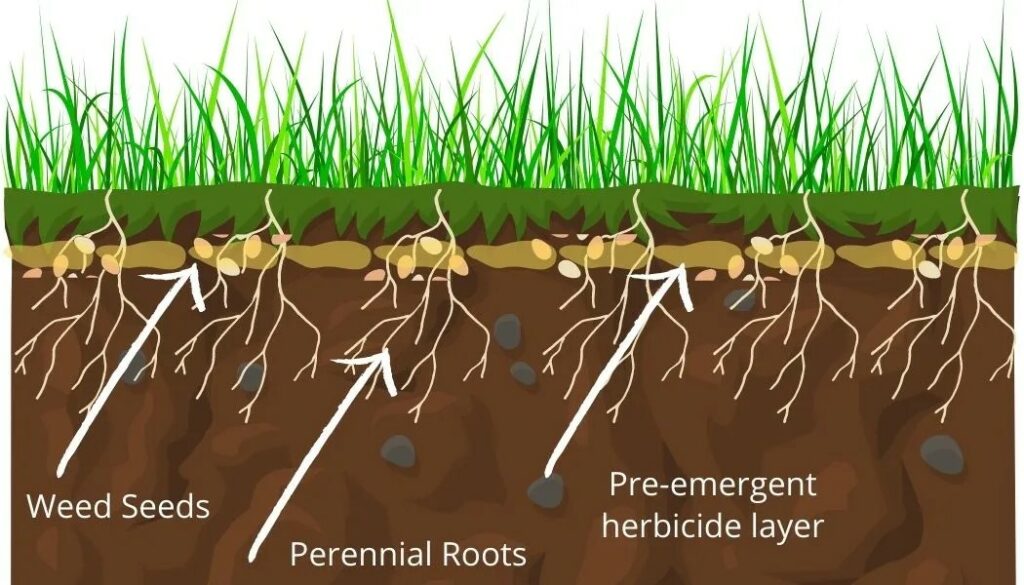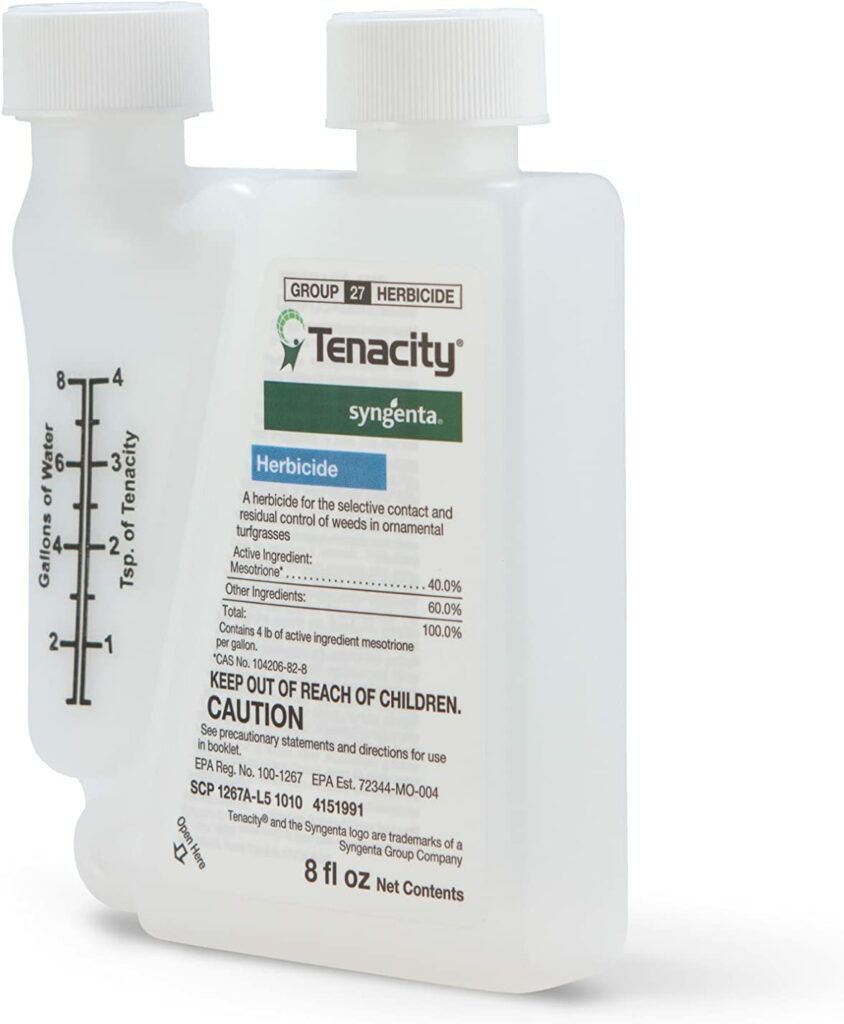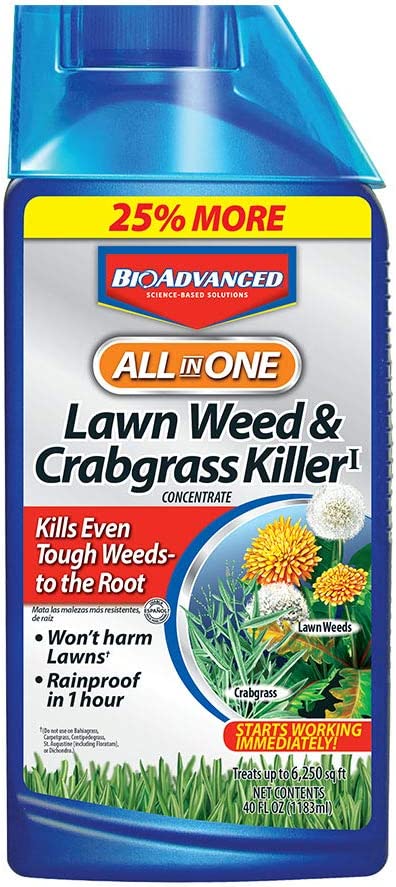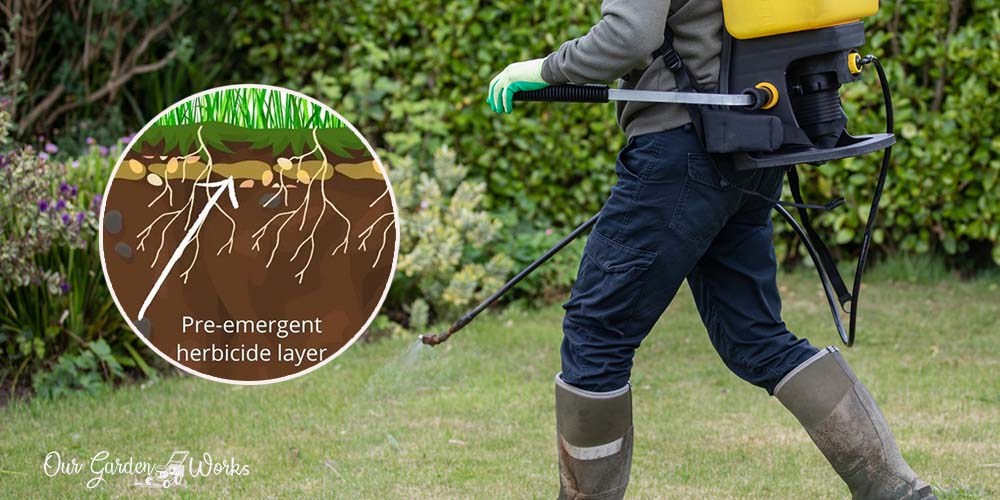The soil needs to fully absorb pre-emergent herbicides or weed killers to prevent weed seeds from sprouting.
However, there are conflicting sources on how and when to apply pre-emergent that confuses most gardeners. We often wonder, can you apply pre-emergent in the rain, after or before the lawn gets soaked with rainwater?
There are several ways for chemicals to penetrate the soil, so the term watering down pre-emergent is too vague for most people.
Weed seeds, like any other seeds, need moisture and a specific temperature to trigger germination. Pre-emergents only work at the exact moment weed seeds germinate.
Hence, a continuous drought in some regions frustrates farmers and other gardeners due to concerns about the efficacy of pre-emergent herbicides.
According to Iowa State University, pre-emergent herbicides are most efficient when they are already present in the soil before weed seeds absorb water to germinate. So, the question always boils down if you should apply it before, during, or after it rains.
In this post, we will share the best time to apply pre-emergent, the role of rain in pre-emergent weed management, and the science behind it.
First, it’s worth checking how weed seeds germinate and herbicides work.
How Does Pre-emergent Herbicide Work?

In a nutshell, pre-emergents inhibit cell division in germinating weed seeds to prevent them from developing roots and stems.
They contain chemicals that coat the topsoil and target the active enzyme in weed seeds while they germinate. Pre-emergent is commonly used for managing crabgrass on farms and lawns.
Pre-emergent weed killers can no longer control established weeds. In such cases, you’ll need to use post-emergent herbicides. Successful weed management throughout the season is based on the following factors:
- Temperature.
- Season.
- Rainfall or watering schedule.
- Soil moisture levels.
- Soil structure.
Rain is a free resource that gardeners need to successfully let the soil absorb the chemicals from pre-emergent. There should be at least ½ inch of rain to secure full penetration of chemicals in the soil profile.
If the soil is too dry, you’ll need more rain to ensure that the chemicals will reach the first 2 inches of soil.
If the soil is composed of fast-draining materials like sand, it will require less rain to activate the herbicidal effect of pre-emergents.
The Confusion in Applying Pre-emergent
The confusion on pre-emergent herbicide application often stems from the ambiguity of the instruction when dealing with rain.
Novice gardeners are often dumbfounded on when can you apply pre-emergent: in the rain or after it rains?
Here are some confusing practices revolving around pre-emergent weed killers:
- Some believe it’s a bit logical to spray pre-emergent when it’s raining to simultaneously allow the soil to absorb both moisture and pre-emergent weed killers.
- Other gardeners speculate that the soil will absorb the pre-emergent chemicals if it is applied after it rains. The soil has enough moisture that will seep down as the ground flushes excess water.
- Most professionals believe that you should apply pre-emergent chemicals before it rains to set the chemicals next to the weed seeds. As the rain pours down, the pre-emergent chemicals are in the strategic location in the soil to provide better coverage of the first two inches of topsoil.
Q: Can You Apply Pre-emergent in The Rain?
A: According to agriculture specialists at the University of Iowa, the best practice is to apply pre-emergent before it rains.
Simultaneously applying pre-emergent when the rain is pouring will only cause the chemicals to go down the drain rather than be saturated in the soil.
The most ideal conditions to apply pre-emergent are as follows:
- Soil is moist or dry, not soggy.
- Balanced water-retaining and water-draining soil structure.
- Temperature ranging from: 65°F–70°F for four consecutive days (spring); 55°F–60°F for four consecutive nights(fall).
- Light to moderate rain is expected within 5 to 7 days after application.
The advantage of setting the pre-emergent in the soil before it rains is allowing the chemicals to be initially absorbed in the soil before it leaches off in case there’s excessive rainfall.
According to the NC State University, when there’s excessive rainfall it can be hard to gauge the efficiency of herbicide and only time can tell if there’s enough pre-emergent retained in the soil.
The standard rule is to schedule the pre-emergent application if there’s an upcoming rainfall within five to seven days of application.
Delayed rainfall from the date of application is the common culprit behind residual herbicide failures.
How much moisture is too much for a pre-emergent herbicide?
Too much moisture for pre-emergent herbicides depends on the soil structure. If the soil is too dry, the soil will need an inch of rain or more to activate the herbicidal effect of pre-emergent.
However, if the soil is damp and contains compost and water-retaining components, ½ inch of rain is enough.
It’s a different story if you have sandy soil on your lawn. If there are more water-draining components in the soil, then light rainfall, ranging from ¼ to ½ inch, will be enough to penetrate the first two inches of the soil.
When Is The Best Time To Apply Pre-emergent Herbicide?
Early spring and fall is the best time to apply pre-emergent weed killers in garden beds and lawns.
Some gardeners argue that it depends on the region. Locals use the wilting of local forsythia and the time before azaleas bloom as indications to apply pre-emergent.
Warm season grass/Spring pre-emergent application
Aside from season, another consideration in applying pre-emergent herbicide is when it reaches the ideal temperature for 2 to 3 consecutive days in a specific region. These particular conditions are the high time for warm season weed seeds to sprout.
Since every region has a varying climate and weather changes, here’s a guide that’s around the ballpark of the specific application schedule for spring:
- Northern states: March.
- Southern states: June.
Cold season grass/Fall pre-emergent application
For fall pre-emergent application, you should wait for the weather to cool down at 55°F to 60°F for 2 to 3 consecutive days.
The timing is important in fall application because you must apply the pre-emergent at the exact time cold season weed seeds are starting to sprout.
You can base your pre-emergent application schedule based on your region below:
- Northern states: August.
- Southern states: November.
Helpful Tips For a Successful Pre-emergent Application
The battle against weeds is tough, especially when dealing with dandelions and other persistent weeds. Their seeds are almost everywhere and only wait to be moved to the surface to get enough sun to germinate.
Here are some tips to gain complete control of weeds in your garden:
(1) Limited rain after pre-emergent application will affect its residual activity regardless if you apply it at full rate.
(2) Dry soil will need more rainwater than usual to allow the chemicals to penetrate the topsoil.
(3) For total weed management, you need to have a follow-up application of pre-emergent after 6 to 8 weeks. In some cases, gardeners use a combination of pre-emergent and post-emergent herbicides as a strategy to kill both weed seeds and established weeds.
(4) Excessive rainfall may cause inconsistencies in the effect of pre-emergent herbicides. In case too much rainfall has swept your lawn after pre-emergent application, you can pair it up with post-emergent to manage those seeds that sprouted.
(5) The only time rainfall delay is allowed is early spring pre-emergent application. No weed seeds sprout too early in the season.
(6) Pre-emergent spring application helps control notorious summer weeds like crabgrass, sandbur, and foxtails. In fall, it helps manage pesky chickweeds and henbit.
(7) Apply pre-emergent on bald spots earlier that the other parts of the lawn because they get warmer faster than the rest of the yard.
(8) You should only apply pre-emergent to lawns that are more than one year old.
The 3 Best Pre-emergent Herbicides To Try
There are tons of agricultural-grade pre-emergent weed killers in the market. However, the following are the most recommended brands for most professionals:
1. Syngenta Tenacity 8oz Herbicide

Tenacity is probably the best herbicide in the market since it is both a pre-emergent and post-emergent weed killer. It is also made of organic compounds which makes it less risky to use around kids and pets.
If you want an all-in-one weed control, you should give Tenacity a try. However, it limits the growth of fine fescue and should not be applied right after seeding the lawn.
2. BIOADVANCED All-in-One Lawn Weed And Crabgrass Killer

Bio-Advanced Lawn Weed Killer is a pre-emergent herbicide that’s rain-proof for an hour.
It will not harm most lawn grass varieties but may damage Bahia, Bermuda, Carpet, and St. Augustine grass with incorrect application rate and temperature. It is most preferred by gardeners who want a cheaper alternative to Tenacity.
3. Scotts Halts Crabgrass & Grassy Weed Preventer

Scotts is the best brand to try if you want to get rid of weeds and moss in the fall. It also has a bigger coverage in every pack and can be applied in any weather.
However, it can cause damage when seeding your lawn due to its pendimethalin content.
Frequently Asked Questions (FAQs)
Can you apply pre-emergent on wet grass?
Wet grass is an indication of soggy soil. When the soil is too soggy, it is filled with water and can no longer absorb the chemicals from the pre-emergent herbicide. Therefore, the substances remain on the soil surface.
Should I mow before pre-emergent?
Yes. Reducing the grass height will help the pre-emergent seep deeper into the topsoil.
Also, you cannot mow the lawn after applying pre-emergent herbicide because it takes a day or two for the herbicide to penetrate the ground. Wait for 3 days to a week before you mow your lawn again.
How long after pre-emergent can I water?
If there’s a good amount of rain within 3 to 5 days after application, you no longer need to water your lawn for a week. However, you can supplement the lack of rain by watering your lawn for 30 minutes after 3 days.
How long is pre-emergent effective?
The average residual activity of pre-emergent herbicides is up to three months. However, its lifespan can also be affected by several factors like excessive rainfall and sandy soil structure.
Final Thoughts
We hope that this post cleared the confusion and questions like can you apply pre-emergent in the rain or not. Searching online and consulting several gardeners may give you conflicting opinions.
However, considering expert opinions is key for successful weed management using pre-emergents.
How’s your first time using pre-emergents? Did it cause damage to your lawn or did some weeds manage to survive?
Let us know in the comments below! Also, please don’t forget to share the post with your friends so they can avoid costly mistakes on their lawns.
